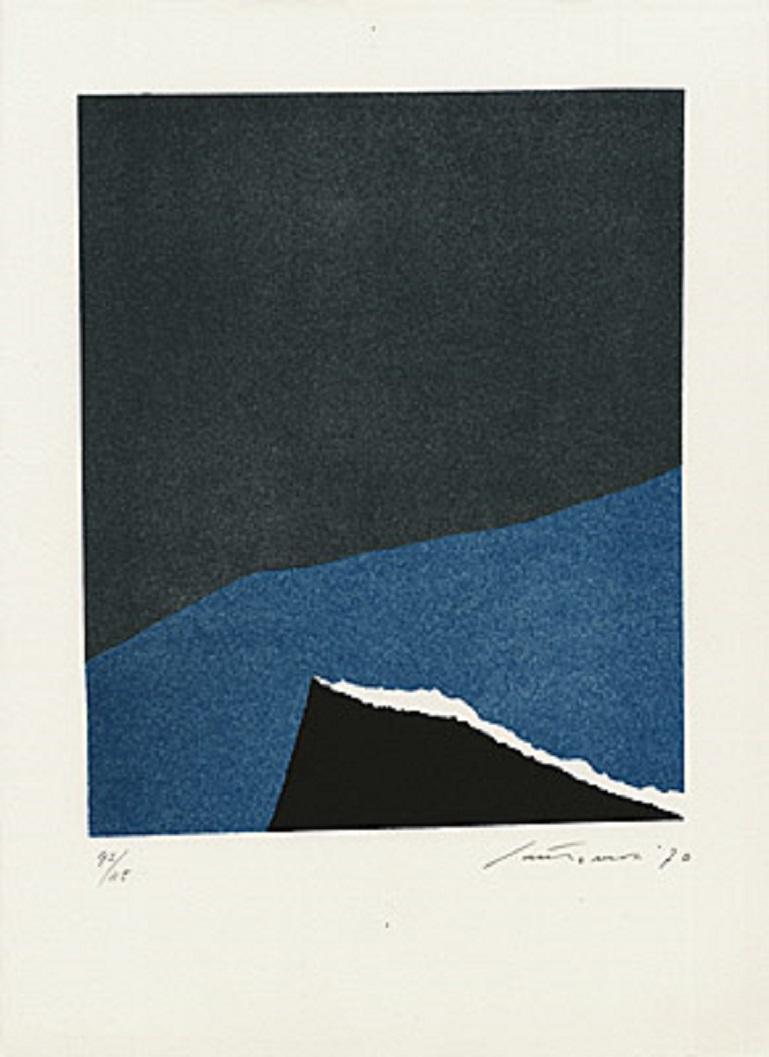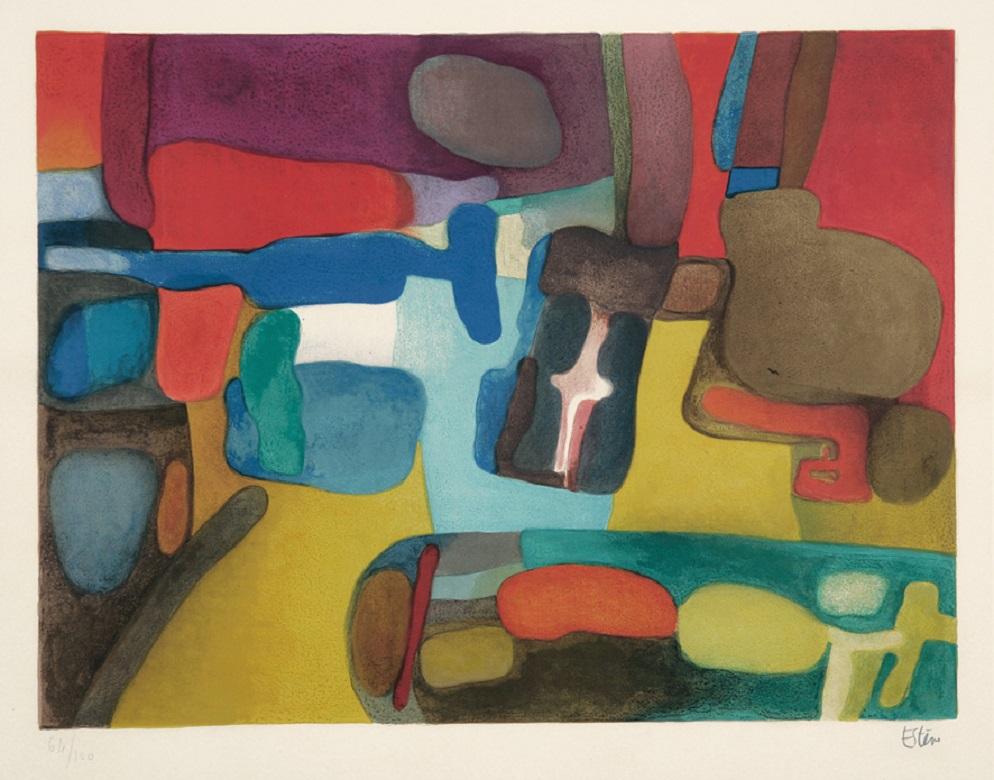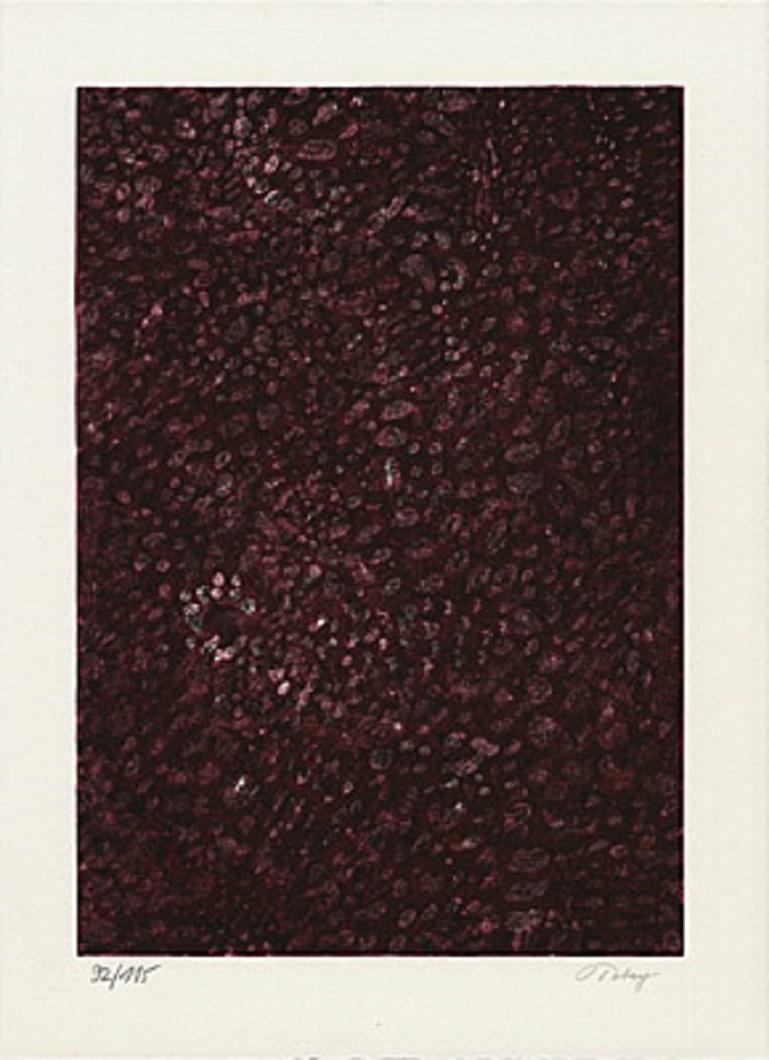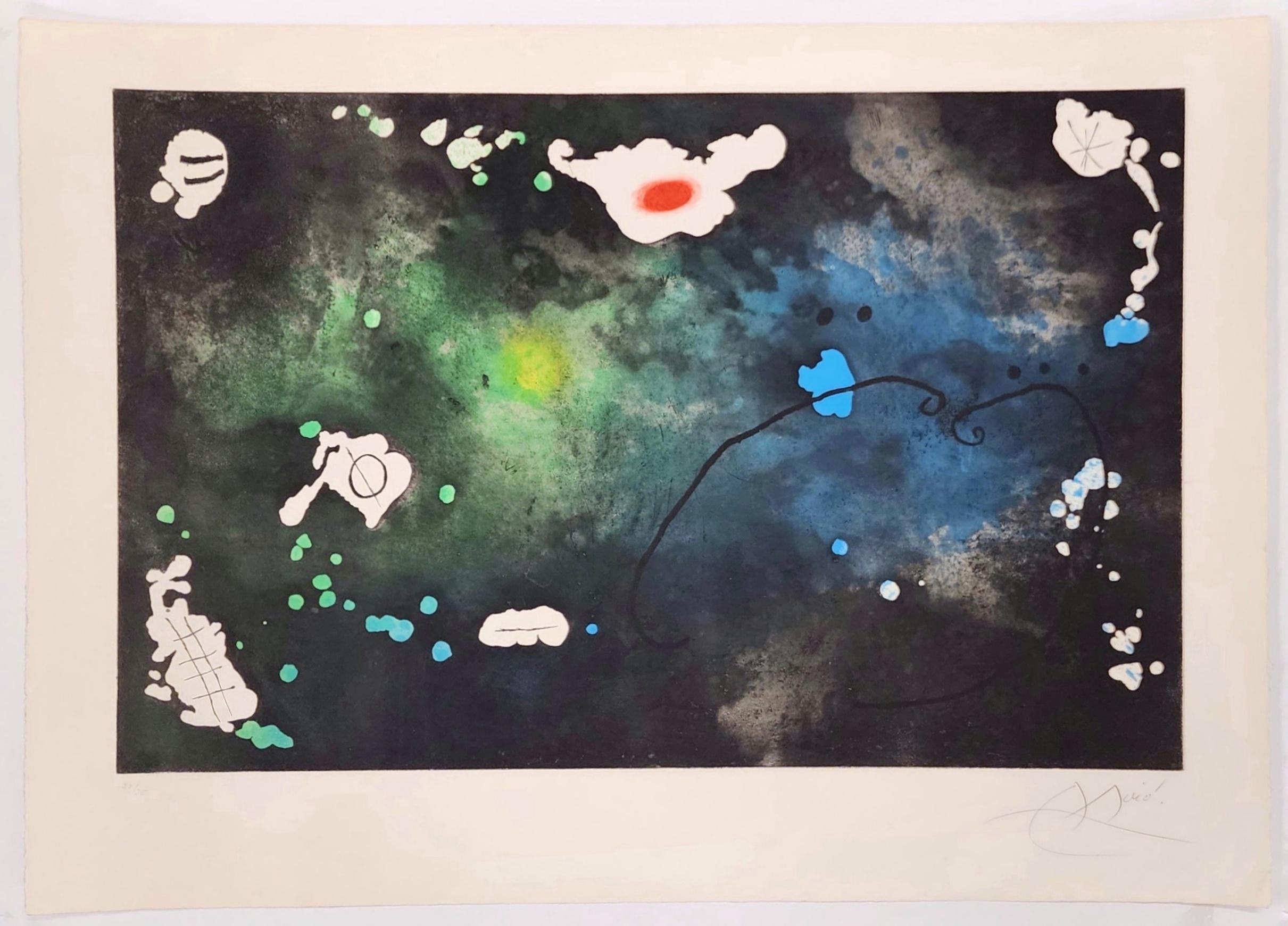Alexander CalderRed and Blue Spirals
About the Item
- Creator:Alexander Calder (1898 - 1976, American)
- Dimensions:Height: 26 in (66.04 cm)Width: 37 in (93.98 cm)
- Medium:
- Movement & Style:
- Period:
- Condition:
- Gallery Location:Missouri, MO
- Reference Number:1stDibs: LU747314223962
Alexander Calder
The American sculptor Alexander Calder is known as the father of the mobile, a moving artwork composed of delicately balanced sculptural forms suspended from the ceiling.
Because Calder's parents, both artists themselves, did not want him to suffer the hardships of trying to make a living in art, they encouraged the young Calder to study mechanical engineering at the Stevens Institute of Technology, in Hoboken, New Jersey. He worked a number of jobs, including as a hydraulic engineer and draftsman for the New York Edison Company, before deciding to pursue an artistic career. He never abandoned his engineering background, however, applying his understanding of gears and moving parts in all his artworks, from mechanical toys like the Cirque Calder (1931) and his revered prints to his free-standing abstract sculptures, called stabiles.
In 1926, Calder moved to Paris and established a studio in the Montparnasse quarter. He began creating the many parts of his famous miniature circus from found materials, such as wire, string, cloth, rubber and cork. Designed to be transportable, Cirque grew to fill five suitcases over the years. Always interested in putting forms in motion, Calder also pioneered a new art form called wire sculptures, which he described as “drawings in space.” Like his famous mobiles, the wire sculptures were suspended so that they turned with any movement of the air, presenting different forms when viewed from different angles.
In the 1950s, Calder returned to his roots in mechanical engineering, creating monumental abstract sculptures that verged on the architectural. He worked from loose gestural drawings like this preparatory sketch for his Man Stabile, from 1966. Throughout his career, he also worked as a set designer for the theater, as well as an illustrator and printmaker, producing vibrant, whimsical drawings for books and journals.
Find original Alexander Calder art today on 1stDibs.
- ShippingRetrieving quote...Ships From: Missouri, MO
- Return PolicyA return for this item may be initiated within 2 days of delivery.
- Blue Rings (Abstract Composition)By Yaacov AgamLocated in Missouri, MOBlue Rings (Abstract Composition), Serigraph By Yaacov Agam (Israeli, b. 1928) Signed Lower Right Edition 8/270 Lower Left Unframed: 21" x 21.5" Framed: 31" ...Category
20th Century Abstract Abstract Prints
MaterialsLithograph
- CurtainBy Yaacov AgamLocated in Missouri, MOCurtain By. Yaacov Agam (Israeli, b. 1928) Signed Lower Right Edition 221/227 Unframed: 18" x 22.5" Framed: 30.5" x 34.5" Yaacov Agam is one of the pioneer creators of the kinetic movement in art as well as its most outstanding contemporary representative. Agam was born in 1928 a son of a Rabbi of Rishon LeZion (Israel), who devoted his life to the study of Jewish religious matters and wrote books. Agam considers himself somehow as a visual continuation of his father's quest for spirituality. He studied at the Bezalel Academy of Art in Jerusalem, and in Switzerland at the Eidgenossische Technische Hochschule and the Zurich University. After arriving to Paris in 1951, Agam held his first one man exhibition with a great success in 1953 This exhibition consisted totally of kinetic, movable and transformable paintings, which actually was the first one-man show in art history exclusively devoted to kinetic art. A passionate experimenter, Agam deals with such problems as the 4th dimension, simultaneity and time in the visual, plastic arts, and has extended his experiments to application in the fields of literature, music and art theory. His works express a concept that breaks away with the established way of expressing reality in limited, static way. In his works, he strives to demonstrate the principle of reality as a continuous "becoming" rather than static "graven image." His paintings Double Metamorphosis 11 in the Museum of Modern Art in New York and Transparent Rhythms 11 in the Hirshhorn Museum and Sculpture Garden of the Smithsonian Institution in Washington, D.C. give the best example of his polymorphic painting. His works are placed in many public places including Communication x 9 on the Michigan Avenue in Chicago (1983), Communication: Night and Day at the AT&T building in New York (1974), Super Lines Volumes at the Pare Floral in Paris (1971), and his murals Peace and Life arc installed at the Parliament of Europe in Strasbourg (1977). Agam has expressed the new concepts in monumental works as in his Jacob's Ladder, which forms the ceiling of the National Convention House in Jerusalem. He created a "floating museum", including all the artworks for public areas and cabins, for the Carnival Cruise Line's luxury cruise ship "Celebration" (1987). His fire-water fountain in Dizengoff Square in Tel Aviv (1986) streams water, fire, and music -elements of flux and life which cannot be static - as its colored elements rotate in this multidimensional monumental work. For the Elysee Palace in Paris, with the request of President Georges Pompidou Agam created in 1972 a whole environmental of the Salon with the walls covered with polymorphic murals of changing images a kinetic ceiling, moving transparent colored doors and a kinetic carpet on which he placed a sculpture. It embraces viewers: they are no longer looking at a framed, fixed scene, but rather arc moving within an artistic space which changes constantly according to their shifting position and point of view. Similar attempt was made for the concert hall, Forum Leverkusen in Germany in 1970. Agam created many environmental sculptures, including Hundred Gates in the garden of the residence of the President of Israel in Jerusalem, 3 x 3 Interplay installed at the Julliard School of Music at the Lincoln Center and Wings of the Heart at J. F. Kennedy airport in New York. In 1984, he made a sculpture Beating Heart for the Hadassah Hospital in Jerusalem. In 1988, he created a transparent torah ark...Category
20th Century Abstract Abstract Prints
MaterialsLithograph
- EmergingBy Yaacov AgamLocated in Missouri, MOEmerging, 1985 By. Yaacov Agam ( Israeli, b. 1928) Color Serigraph Signed Lower Right Edition 1/12 Lower Left Unframed: 25" x 31" Framed: 34" x 43" Yaacov Agam is one of the pioneer creators of the kinetic movement in art as well as its most outstanding contemporary representative. Agam was born in 1928 a son of a Rabbi of Rishon LeZion (Israel), who devoted his life to the study of Jewish religious matters and wrote books. Agam considers himself somehow as a visual continuation of his father's quest for spirituality. He studied at the Bezalel Academy of Art in Jerusalem, and in Switzerland at the Eidgenossische Technische Hochschule and the Zurich University. After arriving to Paris in 1951, Agam held his first one man exhibition with a great success in 1953 This exhibition consisted totally of kinetic, movable and transformable paintings, which actually was the first one-man show in art history exclusively devoted to kinetic art. A passionate experimenter, Agam deals with such problems as the 4th dimension, simultaneity and time in the visual, plastic arts, and has extended his experiments to application in the fields of literature, music and art theory. His works express a concept that breaks away with the established way of expressing reality in limited, static way. In his works, he strives to demonstrate the principle of reality as a continuous "becoming" rather than static "graven image." His paintings Double Metamorphosis 11 in the Museum of Modern Art in New York and Transparent Rhythms 11 in the Hirshhorn Museum and Sculpture Garden of the Smithsonian Institution in Washington, D.C. give the best example of his polymorphic painting. His works are placed in many public places including Communication x 9 on the Michigan Avenue in Chicago (1983), Communication: Night and Day at the AT&T building in New York (1974), Super Lines Volumes at the Pare Floral in Paris (1971), and his murals Peace and Life arc installed at the Parliament of Europe in Strasbourg (1977). Agam has expressed the new concepts in monumental works as in his Jacob's Ladder, which forms the ceiling of the National Convention House in Jerusalem. He created a "floating museum", including all the artworks for public areas and cabins, for the Carnival Cruise Line's luxury cruise ship "Celebration" (1987). His fire-water fountain in Dizengoff Square in Tel Aviv (1986) streams water, fire, and music -elements of flux and life which cannot be static - as its colored elements rotate in this multidimensional monumental work. For the Elysee Palace in Paris, with the request of President Georges Pompidou Agam created in 1972 a whole environmental of the Salon with the walls covered with polymorphic murals of changing images a kinetic ceiling, moving transparent colored doors and a kinetic carpet on which he placed a sculpture. It embraces viewers: they are no longer looking at a framed, fixed scene, but rather arc moving within an artistic space which changes constantly according to their shifting position and point of view. Similar attempt was made for the concert hall, Forum Leverkusen in Germany in 1970. Agam created many environmental sculptures, including Hundred Gates in the garden of the residence of the President of Israel in Jerusalem, 3 x 3 Interplay installed at the Julliard School of Music at the Lincoln Center and Wings of the Heart at J. F. Kennedy airport in New York. In 1984, he made a sculpture Beating Heart for the Hadassah Hospital in Jerusalem. In 1988, he created a transparent torah ark...Category
20th Century Abstract Abstract Prints
MaterialsLithograph
- Untitled, (Serigraph)By Yaacov AgamLocated in Missouri, MOUntitled (Serigraph) By Yaacov Agam (Israeli, b. 1928) Signed Lower Right Edition 56/180 Lower Left Unframed: 20" x 8" Framed: 26.25" x 14" Yaacov Agam is one of the pioneer creators of the kinetic movement in art as well as its most outstanding contemporary representative. Agam was born in 1928 a son of a Rabbi of Rishon LeZion (Israel), who devoted his life to the study of Jewish religious matters and wrote books. Agam considers himself somehow as a visual continuation of his father's quest for spirituality. He studied at the Bezalel Academy of Art in Jerusalem, and in Switzerland at the Eidgenossische Technische Hochschule and the Zurich University. After arriving to Paris in 1951, Agam held his first one man exhibition with a great success in 1953 This exhibition consisted totally of kinetic, movable and transformable paintings, which actually was the first one-man show in art history exclusively devoted to kinetic art. A passionate experimenter, Agam deals with such problems as the 4th dimension, simultaneity and time in the visual, plastic arts, and has extended his experiments to application in the fields of literature, music and art theory. His works express a concept that breaks away with the established way of expressing reality in limited, static way. In his works, he strives to demonstrate the principle of reality as a continuous "becoming" rather than static "graven image." His paintings Double Metamorphosis 11 in the Museum of Modern Art in New York and Transparent Rhythms 11 in the Hirshhorn Museum and Sculpture Garden of the Smithsonian Institution in Washington, D.C. give the best example of his polymorphic painting. His works are placed in many public places including Communication x 9 on the Michigan Avenue in Chicago (1983), Communication: Night and Day at the AT&T building in New York (1974), Super Lines Volumes at the Pare Floral in Paris (1971), and his murals Peace and Life arc installed at the Parliament of Europe in Strasbourg (1977). Agam has expressed the new concepts in monumental works as in his Jacob's Ladder, which forms the ceiling of the National Convention House in Jerusalem. He created a "floating museum", including all the artworks for public areas and cabins, for the Carnival Cruise Line's luxury cruise ship "Celebration" (1987). His fire-water fountain in Dizengoff Square in Tel Aviv (1986) streams water, fire, and music -elements of flux and life which cannot be static - as its colored elements rotate in this multidimensional monumental work. For the Elysee Palace in Paris, with the request of President Georges Pompidou Agam created in 1972 a whole environmental of the Salon with the walls covered with polymorphic murals of changing images a kinetic ceiling...Category
20th Century Abstract Abstract Prints
MaterialsLithograph
- SpectrumBy Yaacov AgamLocated in Missouri, MOSpectrum By. Yaacov Agam (Israeli, b. 1928) Signed Lower Right Edition 158/180 Lower Left Unframed: 27" x 33.5" Framed: 36.5" x 43" Yaacov Agam is one of the pioneer creators of the kinetic movement in art as well as its most outstanding contemporary representative. Agam was born in 1928 a son of a Rabbi of Rishon LeZion (Israel), who devoted his life to the study of Jewish religious matters and wrote books. Agam considers himself somehow as a visual continuation of his father's quest for spirituality. He studied at the Bezalel Academy of Art in Jerusalem, and in Switzerland at the Eidgenossische Technische Hochschule and the Zurich University. After arriving to Paris in 1951, Agam held his first one man exhibition with a great success in 1953 This exhibition consisted totally of kinetic, movable and transformable paintings, which actually was the first one-man show in art history exclusively devoted to kinetic art. A passionate experimenter, Agam deals with such problems as the 4th dimension, simultaneity and time in the visual, plastic arts, and has extended his experiments to application in the fields of literature, music and art theory. His works express a concept that breaks away with the established way of expressing reality in limited, static way. In his works, he strives to demonstrate the principle of reality as a continuous "becoming" rather than static "graven image." His paintings Double Metamorphosis 11 in the Museum of Modern Art in New York and Transparent Rhythms 11 in the Hirshhorn Museum and Sculpture Garden of the Smithsonian Institution in Washington, D.C. give the best example of his polymorphic painting. His works are placed in many public places including Communication x 9 on the Michigan Avenue in Chicago (1983), Communication: Night and Day at the AT&T building in New York (1974), Super Lines Volumes at the Pare Floral in Paris (1971), and his murals Peace and Life arc installed at the Parliament of Europe in Strasbourg (1977). Agam has expressed the new concepts in monumental works as in his Jacob's Ladder, which forms the ceiling of the National Convention House in Jerusalem. He created a "floating museum", including all the artworks for public areas and cabins, for the Carnival Cruise Line's luxury cruise ship "Celebration" (1987). His fire-water fountain in Dizengoff Square in Tel Aviv (1986) streams water, fire, and music -elements of flux and life which cannot be static - as its colored elements rotate in this multidimensional monumental work. For the Elysee Palace in Paris, with the request of President Georges Pompidou Agam created in 1972 a whole environmental of the Salon with the walls covered with polymorphic murals of changing images a kinetic ceiling, moving transparent colored doors and a kinetic carpet on which he placed a sculpture. It embraces viewers: they are no longer looking at a framed, fixed scene, but rather arc moving within an artistic space which changes constantly according to their shifting position and point of view. Similar attempt was made for the concert hall, Forum Leverkusen in Germany in 1970. Agam created many environmental sculptures, including Hundred Gates in the garden of the residence of the President of Israel in Jerusalem, 3 x 3 Interplay installed at the Julliard School of Music at the Lincoln Center and Wings of the Heart at J. F. Kennedy airport in New York. In 1984, he made a sculpture Beating Heart for the Hadassah Hospital in Jerusalem. In 1988, he created a transparent torah ark...Category
20th Century Abstract Abstract Prints
MaterialsLithograph
- Abstract Purple, Blue, GreensBy Yaacov AgamLocated in Missouri, MOAbstract Purple, Blue, Greens (Serigraph) By Yaacov Agam (Israeli, b. 1928) Signed Lower Right Edition 4/30 Lower Left Unframed: 14" x 33" Framed: 21" x 41" Yaacov Agam is one of the pioneer creators of the kinetic movement in art as well as its most outstanding contemporary representative. Agam was born in 1928 a son of a Rabbi of Rishon LeZion (Israel), who devoted his life to the study of Jewish religious matters and wrote books. Agam considers himself somehow as a visual continuation of his father's quest for spirituality. He studied at the Bezalel Academy of Art in Jerusalem, and in Switzerland at the Eidgenossische Technische Hochschule and the Zurich University. After arriving to Paris in 1951, Agam held his first one man exhibition with a great success in 1953 This exhibition consisted totally of kinetic, movable and transformable paintings, which actually was the first one-man show in art history exclusively devoted to kinetic art. A passionate experimenter, Agam deals with such problems as the 4th dimension, simultaneity and time in the visual, plastic arts, and has extended his experiments to application in the fields of literature, music and art theory. His works express a concept that breaks away with the established way of expressing reality in limited, static way. In his works, he strives to demonstrate the principle of reality as a continuous "becoming" rather than static "graven image." His paintings Double Metamorphosis 11 in the Museum of Modern Art in New York and Transparent Rhythms 11 in the Hirshhorn Museum and Sculpture Garden of the Smithsonian Institution in Washington, D.C. give the best example of his polymorphic painting. His works are placed in many public places including Communication x 9 on the Michigan Avenue in Chicago (1983), Communication: Night and Day at the AT&T building in New York (1974), Super Lines Volumes at the Pare Floral in Paris (1971), and his murals Peace and Life arc installed at the Parliament of Europe in Strasbourg (1977). Agam has expressed the new concepts in monumental works as in his Jacob's Ladder, which forms the ceiling of the National Convention House in Jerusalem. He created a "floating museum", including all the artworks for public areas and cabins, for the Carnival Cruise Line's luxury cruise ship "Celebration" (1987). His fire-water fountain in Dizengoff Square in Tel Aviv (1986) streams water, fire, and music -elements of flux and life which cannot be static - as its colored elements rotate in this multidimensional monumental work. For the Elysee Palace in Paris, with the request of President Georges Pompidou Agam created in 1972 a whole environmental of the Salon with the walls covered with polymorphic murals of changing images a kinetic ceiling, moving transparent colored doors and a kinetic carpet on which he placed a sculpture. It embraces viewers: they are no longer looking at a framed, fixed scene, but rather arc moving within an artistic space which changes constantly according to their shifting position and point of view. Similar attempt was made for the concert hall, Forum Leverkusen in Germany in 1970. Agam created many environmental sculptures, including Hundred Gates in the garden of the residence of the President of Israel in Jerusalem, 3 x 3 Interplay installed at the Julliard School of Music at the Lincoln Center and Wings of the Heart at J. F. Kennedy airport in New York. In 1984, he made a sculpture Beating Heart for the Hadassah Hospital in Jerusalem. In 1988, he created a transparent torah ark...Category
20th Century Abstract Abstract Prints
MaterialsLithograph
- Cali - 20th Century, Maurice Estève, Abstract Print, Colourful, LithographBy Maurice EstèveLocated in Köln, DE"Cali" is a typical motif by Maurice Estève. The lithograph in colours was published in an edition of 100. 49,6 x 65 cm. Signed and numbered.Category
1960s Abstract Abstract Prints
MaterialsLithograph
- Untitled from "Vingt-deux poèmes" by Giuseppe Santomaso, Black, Blue, CassouBy Giuseppe SantomasoLocated in Köln, DEColor lithograph by Giuseppe Santomaso Untitled from "Vingt-deux-poèmes" (Portfolio with artworks by several artists and 22 poems by Jean Cassou. The work...Category
1970s Abstract Abstract Prints
MaterialsLithograph
- "El patito feo" by Antonio Saura, Abstract Print, Duckling, Blue, Bright ColorsBy Antonio SauraLocated in Köln, DEColor lithgraph by Antonio Saura "El patito feo", 1997 65 x 50 cm Copy 186/250 Edition of 285 Antonio Saura (Huesca, Spain 1930–1998 Cuenca) found his...Category
1990s Abstract Abstract Prints
MaterialsLithograph
- Untitled from "Vingt-deux poèmes" by Mark Tobey, Lithography, Cassou, Black, RedBy Mark TobeyLocated in Köln, DEColor lithograph by Mark Tobey (Centerville, Wisconsin 1890 - 1976 Basel) from "Vingt-deux poèmes" (Portfolio with artworks by several artists and 22 poems by Jean Cassou...Category
1960s Abstract Expressionist Abstract Prints
MaterialsLithograph
- Untitled from "San Lazarro et ses amis" by Zao Wou-Ki, Lithography, Blue, GreenBy Zao Wou-KiLocated in Köln, DEColor lithograph by Wou-Ki Zao Untitled from "San Lazarro et ses amis" (portfolio with texts by Yvon Taillandier), 1975 56,5 x 37 cm Copy e.a. Edition of 50 Zao Wou-Ki (Peking 19...Category
1970s Abstract Abstract Prints
MaterialsLithograph
- Archipel Sauvage IVBy Joan MiróLocated in Grand Rapids, MIJoan Miró (Spanish, 1893-1983) Signed: Miro (Lower, Right) " Archipel Sauvage IV ", 1970 (Titled on Verso) Etching Aquatint Printed in Colours Numbered: 22/35 Sheet Size: 29 5/...Category
Mid-20th Century Abstract Abstract Prints
MaterialsLithograph
Recently Viewed
View AllRead More
Renowned for His Mobiles, Alexander Calder Was Also Adept at Crafting Modernist Jewelry
There are no sparkling gemstones on this necklace, but its value far exceeds the cost of its materials.
10 Must-Visit American Public Sculptures
Get your dose of Vitamin D while surveying works by the likes of Alexander Calder, Keith Haring and Pablo Picasso.






